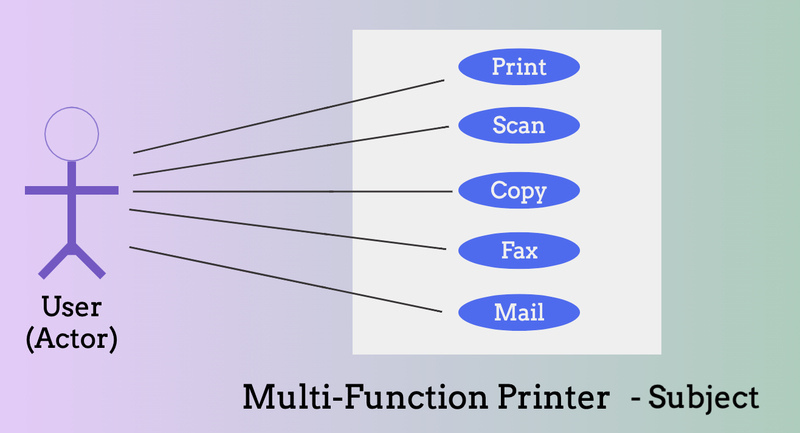Use Case Testing is a method of black box testing that focuses on evaluating the software application from the user's perspective. The test cases are derived from documented use cases, which define a user's interactions with the system or product. Before proceeding with the testing process, it is essential to have a clear understanding of the use cases.
Table of Contents
- What are Use Cases?
- Use Case Example
- Use Case Diagram
- Use Case Description
- Use Case Testing
- Use Case Testing Coverage
- Benefits of Use Case Testing
- Limitations of Use Case Testing
- Video Tutorial
What are Use Cases?
Use Cases are a comprehensive approach to designing user interactions with software systems and incorporating functional requirements for the software. They are based on the concept of 'User Actions' and 'System Responses,' which describe the interactions between various actors and the subject of the use case. Where,
- Actors can be human users, external hardware devices, or other components,
- while the subject is the component or system to which the use case is applied.
Each use case defines the behavior that can be performed by the subject in collaboration with one or more actors and may result in changes to the subject's state. The interactions between actors and subjects can be represented through various graphical techniques such as workflows, activity diagrams, or business process models.
Use Case Example
For example, consider a multi-function printer with five main functions: print, scan, copy, fax, and mail. In this scenario, the user acts as the Actor who interacts with the system, and the multi-function printer is subject. Each function represents a separate use case, leading to a total of five use cases:
- Print Document
- Scan Document
- Copy Document
- Fax Document
- Mail Document
The following use case diagram and accompanying description further illustrate these use cases.
Use Case Diagram
The arrow in the use case diagram represents the relationship between the Actor and the function, indicating the flow of interactions between the two entities.

Use Case Description
A use case is typically described through its interactions and activities, as well as its preconditions, postconditions, and natural language where relevant. The tester can obtain additional detail by consulting the 'Use Case Description' document, which outlines the sequence of events between the Actor and the system during the execution of a use case.
| Use Case ID | MP001 |
| Description | Print Document |
| Actors | User |
| Pre-Conditions |
|
| Post-Condition | Document Printed |
| Trigger / Event | User Clicked on Print Option from device |
| Main Scenario (Basic Path) | |
| |
| Extensions (Alternative Path) | |
| |
| Exception Path | |
| |
Use Case Testing
Use case testing provides transactional, behavior-based tests that should emulate the intended use of the component or system specified by the use case.
Before the initiation of the development phase, use cases are meticulously documented. The testing team leverages these use case documents to formulate test cases, making it a widely adopted technique in creating a system or acceptance-level tests. Additionally, if the use cases outline the behavior of components or systems, they may also be utilized in integration testing. Furthermore, use cases, which depict the practical utilization of the system, serve as the foundation for performance testing.
A use case contains the various iterations of its basic functionality, including unusual behavior and error-handling scenarios (such as the system's response and recovery mechanisms for programming, application, and communication errors, which may result in the display of error messages). The testing process involves the planned execution of the defined behaviors (including the basic, exceptional, alternative, and error-handling scenarios) to ensure their proper functioning.
Use Case Testing Coverage
The minimum acceptable level of coverage of a use case is to have one test case for the basic behavior and sufficient additional test cases to cover each alternative and error-handling behavior. Coverage can be measured by the following: The number of use case behaviors tested divided by the total number of use case behaviors. Test Coverage is usually expressed as a percentage.
Benefits of Use Case Testing
The benefits of Use Case Testing are as follows:
- Improved User Experience: The testing team can identify user experience issues by considering the end-users perspective, thereby adding value to the testing process.
- Efficient Test Case Design: With the use case document readily available before the development phase, the testing team can promptly commence work on the test cases, reducing the time required for test case design. Each use case description serves as a useful guide for the testing team during the test case formulation process.
- Reduce Test Case Complexity: The testing team's ability to follow the paths and flows specified in the use case document results in a reduced test case complexity, facilitating a more streamlined testing process.
Limitations of Use Case Testing
The limitations of Use Case Testing are as follows:
- Need for Realistic User Transactions: Use cases must accurately depict realistic user transactions to be valid. Its value is diminished if the use case does not accurately reflect user and organizational requirements or impedes rather than facilitates user tasks.
- Complete Coverage Challenge: A precise definition of exceptional, alternative, and error-handling behaviors is crucial for thorough testing coverage. While use cases are written from the user's perspective, some system scenarios are not reflected in the use case document, making it impossible to achieve 100% test coverage of each system feature.
- Limited Guidance: Use cases should be viewed as a guide but not a comprehensive definition of what should be tested. They may need to provide a clearer definition of the requirements. It is advisable to create additional models, such as flowcharts and decision tables, to improve testing accuracy and validate the use case.
- Log in to post comments